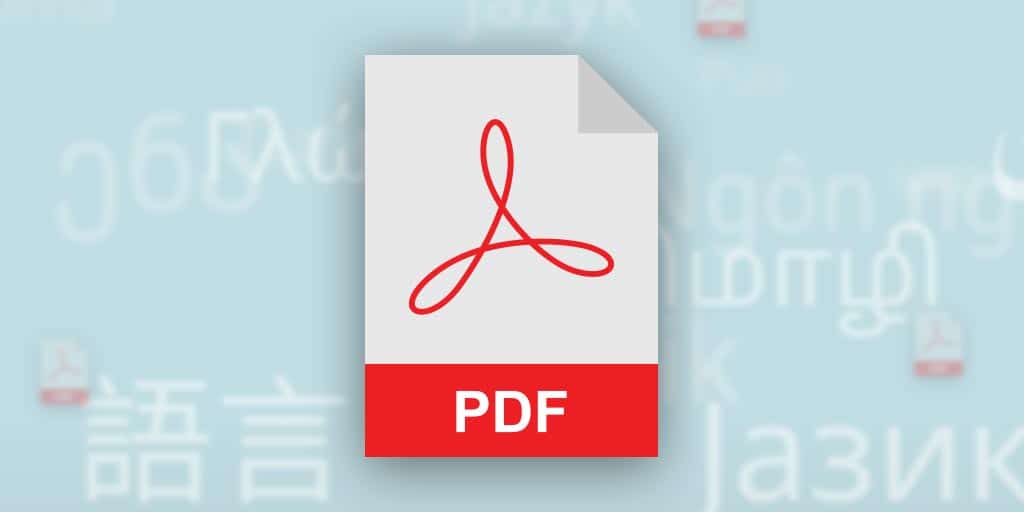
Businesses invest a lot of time and effort into the presentation of their documents. You work to make sure the information is clear, complete, and easy to understand. You format it to look sharp, neat, and appealing. Then, you save the file as a PDF to prevent unauthorized edits and make sure it looks uniformly good on every device.
Which is great – until you need to distribute it in a different language.
Because PDFs can be viewed on multiple platforms, devices, and operating systems, they offer an ideal way to connect with customers and employees around the world. Companies rely on PDFs for official documents, user manuals, marketing materials, training materials, and other communications.
For many international businesses, the difficulty lies in translation because PDFs are not easily editable, and you may find yourself creating new documents every time you need to distribute the information in a new language.
The secure nature of the PDF format makes it uniquely difficult for many companies to translate. Many PDF documents, such as brochures and workbooks, are painstakingly formatted, and contain images and other types of graphics (i.e., flowcharts, org charts, etc.). Pasting in translated text without consideration for these design elements leaves the translated document looking messy, unprofessional, and second-rate – surely not the impression you are trying to make.
Automated PDF translation vs. human translators
Many companies look for a quick solution and trust their PDF translation to an automated system – and then live to regret it.
Artificial Intelligence (AI) is still notoriously unreliable at language translation. While AI can follow simple commands, human language is complex and ever-evolving.
It’s also impossible for AI to appreciate the nuances of idioms and cultural context. If your document warns the reader not to “cut corners,” will the AI logic understand it to mean not to skip steps in the work? Or will it literally tell the reader not to remove the corners from a task?
A professional human translator, on the other hand, brings the expertise to reliably and accurately translate your PDF into any language. Your translated PDF will be technically accurate and culturally on target, as well as being properly formatted so your audience doesn’t feel like they’re getting a second-rate version of the information.
PDF translation process
Interpro is ISO 9001:2015 and ISO 17100:2015 certified, meaning, our professional translators follow rigorous processes when translating PDFs (or any other materials) in order to produce a quality product. After extracting the source text, we translate it, taking care to localize the language to the specific region where the final document will be distributed. Once translated, it is then revised and edited prior to undergoing final Quality Assurance before delivery.
For example, while populations in Spain, Mexico, and Chile all speak Spanish, each geography has its own distinct nuances. Likewise, a PDF translated into French for a Canadian audience will be different from one translated for a European French audience.

Once the translator is satisfied that the target language accurately conveys the meaning of the source language, the translated content is handed over to a multilingual desktop publishing specialist.
These professionals format the translated text to mirror the design of the original document. In most cases, adjustments need to be made to accommodate the translated content.
For example, translated text may take up more or less space than the source-language content. You can make your document more translation-friendly by leaving wide margins on each page in your original design, so there is space for text to expand if necessary.
When translating a language like English, which is read left-to-right, into a language like Farsi, which is read right-to-left, the desktop publishing specialist will need to tweak the design in order for the text to flow more naturally.
This formatting step makes sure every audience gets the benefit of an attractive, high-quality document. Besides making sure the text flows smoothly and is easy to read, a design professional will make sure graphic elements are properly adjusted where necessary, maintaining the look and feel of the source language layout.
Interpro’s designers have the technical expertise to make your PDFs print ready. We will work directly with your print provider to match your document to the specifications they need.
Translating PDFs with images
Another way to make your PDFs translation-friendly is by minimizing the amount of text embedded in graphic elements.
A flowchart, for example, is a graphic with a number of text labels. Once you save that graphic as an image, those labels revert from being live text to simply being part of the image. This will add a few manual steps to the formatting process. The text will need to be manually extracted for translation, and the typesetting in the image will need to be redone.
When including text-heavy graphics like charts within a document, be sure to keep the original, editable source files saved along with your document files so that you can reproduce them when it’s time to translate. When you have the option of using a graphic with text or a graphic without, opt for the one without.
PDF translation without a source file
When viewing a PDF, you are looking at a snapshot that was created in another application, such as Microsoft Word or InDesign, for example. With PDF translation, it is always most efficient to work with the source authoring file, such as the original Microsoft Word document. A quality translation provider will have the technical capability to work with a wide variety of authoring applications, including Microsoft Word (.DOCX), Adobe InDesign (.INDD), and Adobe Photoshop (.PSD), to name a few.
Sometimes the source file may have been lost to time. That doesn’t mean the PDF can’t be translated, it just means that additional steps must be taken to recreate it. First, the text is extracted from the PDF and placed into an editable format. Once the translation is complete, desktop publishers will create a new document that looks as close as possible to the original.
These extra steps invariably incur additional cost and time. When creating new documents, keep the source files saved together with the PDF. When it is time to translate – whether that’s six months or six years later – everything will be available at your fingertips.
The globalization and digitization of the business world are happening hand in hand. Providing your business documents in both the format and the language your audiences need is no longer a luxury – it’s an expectation. The most effective, efficient way to share your messages with your target audience is by partnering with a full-service translation provider experienced in PDF translation.
Category: Translation
Tags: PDF Translation
Service: Document Translation
Don't forget to share this post!
Stay Updated with Interpro
Subscribe to our newsletter for the latest updates and insights in translation and localization.







